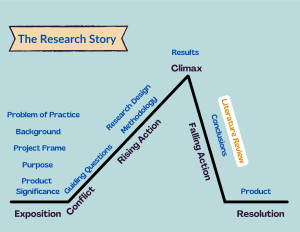Capstone Components
15 Literature Reviews
The story continues…
“Now that we have some empirical results, we need to look for other published research to support our results and find out what other elements are needed to build our strategy for saving your cheese, ” said Physicus.
“So, how do we find out those things?” asked Harry while Physicus was searching for something on his computer.
“Hmm, hmm, this is interesting… no not this… hmm… what?” asked Physicus. “Oh yes, first we need to see if our findings about the number of mice influencing Pickles to disengage holds water,” Physicus said.
“What do you mean holds water?” asked Harry. “We found a study about the number of prey affecting how animals hunt,” Harry said.
“We did, but that was only one research article,” Physicus explained. “We need to make sure that this is a strong finding noted in other research.”
“But I thought since we had an article, it was enough,” said Harry.
“Well, Harry, when you did not know why Pickles would not go after the mice, what did you do?” Physicus questioned.
“I went to talk with you,” Harry replied.
“Yes, and what did I do?” asked Physicus.
“Well, you searched on Google Scholar,” said Harry.
Physicus smiled. “Yes, and did you search Google before that?”
“I did,” replied Harry, not understanding where this conversation was going.
“You see,” said Physicus, “we had to put together several pieces of information to get the hunch or hypothesis. That information informed our needs assessment. Now, if we analyze other published research more formally, we can determine if there are other elements to help us in building a product to solve the problem.”
“But how can we do that? Isn’t it enough to simply explain our findings?” Harry asked.
Physicus thought a little and then replied, “Harry, if you had any questions about the article we found, can you talk to the author?”
Harry sensed a trick question. Harry chuckled and said, “As my friend, Physicus says, ‘It depends!’ Maybe the author will not pick up the phone.”
“That’s right. So how do we then learn about the author’s logic in designing the research project that we want to rely on?” Physicus asked.
“I do not know,” answered Harry.
“It is easy,” replied Physicus. “See, research articles have what is called a literature review. This is the section of the article where the author analyzes research findings in the published literature to justify the selection and application to their research project. Analyzing existing research is how we justify our decisions on how we investigated our problem and how we will use prior research to inform decisions about our product. If we want others to benefit from what we learn, we must be able to justify our project!”
Harry and Physicus were hungry, so they ordered a pie from George’s Pizza. Harry exclaimed, “Seriously if you have not had a George’s Pizza, you cannot say that you have ever had a real pizza!”
“I have a theory; a good pizza will put our lit review writing on steroids!” said Physicus.
Interpreting the Story
As Harry learned, there are two reasons for the literature review. First, literature reviews justify the selection of the components for the needs assessment as well as the findings. Second, it informs how to build the solution after the data are collected. The literature review justifies the conclusions based on what is already known. The author presents the cited evidence logically to show how their research project fits into the existing literature.
Literature Reviews
Literature Reviews identify what is known from published research about a topic. It is a survey of scholarly articles, books, dissertations, conference proceedings, and other relevant resources. Sometimes referred to as “research of research”, the review synthesizes known research findings and facts to provide background information and context for a research project and product. See Chapter 1 for additional information on the Literature Review.
The writing in the Literature Review:
-
-
- Identifies gaps in current knowledge
- Avoids duplicating research already conducted on a topic
- Sets the background on what has been explored on a topic so far
- Increases the breadth of knowledge in the topic area
- Presents seminal works in the topic area
- Provides the intellectual context for the work
- Positions the project with other related research
- Provides opposing viewpoints in the topic area
-
Adapted from Greenfield, T. (2002). Research methods for postgraduates. 2nd ed. London: Arnold.
Conducting passive research using keyword searches on topics, concepts, and theories associated with your research project comes first. This means you will search for research articles, published statistics, etc. through your university or college databases, on Google Scholar, or government sites. Refer to Chapter 2 for details on locating research findings and statistics. Essential information and findings are collected along with the references. The goal is to locate all the relevant and current findings with appropriate background information to write an exhaustive survey of published research. In reality, it will be difficult to truly write an exhaustive review, none the less, this is the goal.
As you read through collected resources, essential information, statistics, and research findings are paraphrased and cited. APA style requires you to avoid direct quotes. It is a good idea to write the cited findings as separate sentences. The cited sentences can then be collected and arranged. You may wish to write each cited sentence on a separate notecard to manipulate manually to organize your findings.
The collected findings, information, and statistics are analyzed and grouped based on a commonality or theme. The common theme is written as a phrase and used as a heading in the Literature Review. The cited sentences are organized logically within the themed headings. Transition sentences and original writing are integrated to expand and connect the ideas into paragraphs.
The themed headings and paragraphs are arranged so that the Literature Review flows logically. Literature Reviews are structured from broad concepts to specific concepts or chronologically from past to present. The heading is written in a way that leads to new understandings of the topic. New insights about the topic are presented through the connections made among the prior research findings.
Novice writers tend to avoid presenting findings from research that seem contrary to what they think or where they want the project to go. However, the function of the Literature Review is to summarize all the findings known, which includes opposing results. Consideration must be given to all findings, which provide the whole research story. Additionally, the Literature Review must show how your research project fills a niche or gap in what is known. The purpose of formal research is to advance knowledge, rather than investigate what is already known. Writing in the Literature Review explains how the research project advances knowledge.
The function of the Literature Review in the capstone project is to inform the development or building of the product. The findings and themes articulated in the Literature Review forms a foundation for the product. Additionally, the research cited in the heading should support the findings of the needs assessment and identify essential elements to be included in the product. This ensures the product is based on solid research.
telling the research story
The Literature Review tells a story of what was known before, what has been found out recently, and where we are currently in the broader story on the issue or topic. The Literature Review works like a montage in a movie to bring the reader up to date with the current story. It first expands the background story, supporting the conflict, and then contributes to the rising action of the story.
The Literature Review is highly cited, synthesizing research findings and facts to accurately place your research story in current educational history. The past research story must be told first to show where your research story fits into the overall narrative. The heading ends with how your project fills a void in known research.
The Literature Review is found in Chapter 2 of a capstone project. The heading explains the history, context, and an exhaustive survey of the findings and facts to support the need for conducting the active research, and informing the development of the product.


